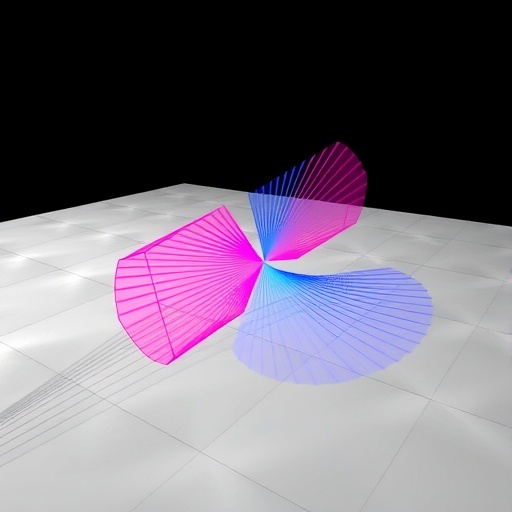
In a groundbreaking advancement that could transform the landscape of nano-optics and photonics, researchers have reported the observation of long-range hyperbolic polaritons on a non-hyperbolic crystal surface. This remarkable finding challenges the long-standing paradigm that hyperbolic polariton phenomena are exclusive to hyperbolic crystals—materials known for their anisotropic permittivity with tensor components of opposite signs. The study opens promising new avenues for dynamically tunable light–matter interactions, achieved on a crystal previously not considered suitable for such exotic excitations.
Polaritons, quasiparticles arising from the strong coupling of photons with matter excitations such as phonons or plasmons, have fueled intense research due to their ability to confine light to nanoscale volumes. Particularly, hyperbolic polaritons—supported by hyperbolic crystals exhibiting dielectric permittivity tensors with hyperbolic dispersion—have captivated scientists owing to their unique properties including highly anisotropic propagation, subwavelength confinement, and negative refraction. These features are central to emerging applications such as super-resolution imaging, integrated nanophotonics, and polaritonic circuitry.
Traditionally, hyperbolic polaritons have been confined to a limited class of materials whose permittivity tensor components exhibit opposite signs over fixed spectral windows—hence the label “hyperbolic.” These spectral constraints have posed significant challenges for tunability and practical device integration. However, the new study dismantles this conceptual boundary by uncovering hyperbolic surface phonon polaritons on the surface of yttrium vanadate (YVO4), a crystal previously characterized as non-hyperbolic because all components of its permittivity tensor share the same negative sign within the frequency range examined.
.adsslot_UwJXCbmI0Q{width:728px !important;height:90px !important;}
@media(max-width:1199px){ .adsslot_UwJXCbmI0Q{width:468px !important;height:60px !important;}
}
@media(max-width:767px){ .adsslot_UwJXCbmI0Q{width:320px !important;height:50px !important;}
}
ADVERTISEMENT
Using cutting-edge real-space nanoimaging techniques, the research team was able to visualize the hyperbolic wavefronts propagating along YVO4 crystal surfaces with high spatial precision. This direct imaging revealed that despite the uniform sign of the permittivity components, surface-confined phonon polaritons exhibited hallmark hyperbolic dispersion signatures. These findings indicate that the conditions for hyperbolic polariton propagation can be more subtle and broader than previously conceived, involving surface effects and anisotropic confinement mechanisms beyond bulk permittivity criteria.
A particularly striking aspect of the investigation is the manipulation of polariton dispersion through controlled temperature variation. By cooling the YVO4 crystal from room temperature down to cryogenic levels, the scientists demonstrated in situ tuning of the polariton properties—including a continuous topological transition of polariton dispersion from hyperbolic regimes through canalization to elliptic dispersion types. This thermally driven dispersion engineering enables unprecedented dynamic control over polariton wavelength, group velocity, and propagation directionality, all within a single material platform.
The ability to modulate polariton behavior via temperature not only enhances basic understanding of light–matter interactions in anisotropic media but also offers a pathway toward reconfigurable photonic devices. These devices could leverage the polariton’s sensitivity and long-range propagation with minimized losses, crucial for practical applications in next-generation optical technologies. Such tunability is pivotal for developing metamaterials and metasurfaces with adaptable optical responses, expanding their operational frequency ranges and functionalities.
By transcending reliance on classical hyperbolic crystals, the discovery expands the materials basis for hyperbolic nano-optics. This breakthrough sets the stage for exploiting a far wider class of anisotropic materials—previously overlooked as non-hyperbolic—for manipulating light at the nanoscale. The implications reach into numerous scientific and technological domains, including negative refraction phenomena, where electromagnetic waves bend opposite to conventional materials, enabling perfect lensing beyond diffraction limits.
The nuanced control of polariton topology and wavefront evolution on YVO4 surfaces also suggests exciting possibilities for superlensing applications. By harnessing hyperbolic polariton modes with long-range, low-loss propagation, optical imaging systems could surpass classical resolution barriers, facilitating nanoscale imaging in chemistry, biology, and materials science with unprecedented clarity and detail.
Furthermore, the intersection of hyperbolic polariton physics with emerging fields like polaritonic chemistry—where quasi-particles influence chemical reactivity—holds promise for novel catalysis mechanisms and energy conversion schemes. Tunable polariton landscapes on a stable, non-hyperbolic material platform can serve as a versatile photonic playground, enabling researchers to tailor light–matter interactions at extreme confinement scales.
Integrated photonics stands to benefit immensely from this innovation. The demonstrated temperature-controlled topological transitions provide a means for on-chip, programmable control of polariton routing and confinement, essential for miniaturized optical circuits. Tailoring group velocities and propagation paths dynamically will allow the design of sophisticated devices such as polariton-based switches, modulators, and sensors that operate across a broad spectral range.
This research also rejuvenates interest in fundamental physics questions concerning optical anisotropy and the nature of polariton dispersion. It challenges the conventional wisdom that ties hyperbolic behavior strictly to permittivity sign disparity, suggesting that surface effects, boundary conditions, and temperature-dependent dielectric properties can orchestrate complex wave phenomena otherwise concealed in non-hyperbolic media.
The long-range propagation and reduced loss reported on the YVO4 surface polaritons are particularly noteworthy, as these qualities underpin efficient information transfer and energy confinement at the nanoscale. Achieving such performance without resorting to artificially structured metamaterials or exotic hyperbolic crystals simplifies fabrication and integration challenges, enhancing scalability and commercial viability.
Overall, the convergence of advanced nanoimaging, theoretical modeling, and temperature-controlled experimentation culminated in this landmark demonstration. It shakes the foundations of hyperbolic nano-optics by revealing that non-hyperbolic crystals can serve as fertile grounds for hyperbolic polariton phenomena, consequently broadening the horizons of photonics research and application.
As this breakthrough stimulates further exploration, it promises to catalyze a new wave of devices and experiments that exploit the newly revealed flexibility of polariton dispersion engineering. From fundamental physics to applied nanotechnology, the unexpected richness of light–matter interaction unveiled in this study will undoubtedly become a cornerstone of future scientific endeavors.
Subject of Research: Long-range hyperbolic surface phonon polaritons realized on non-hyperbolic crystal surfaces and temperature-driven topological dispersion transitions.
Article Title: Long-range hyperbolic polaritons on a non-hyperbolic crystal surface.
Article References:
Liu, L., Xiong, L., Wang, C. et al. Long-range hyperbolic polaritons on a non-hyperbolic crystal surface. Nature (2025). https://doi.org/10.1038/s41586-025-09288-1
Image Credits: AI Generated
Tags: anisotropic permittivity materialshyperbolic polariton phenomenaintegrated nanophotonics developmentslong-range hyperbolic polaritonsnano-optics advancementsnegative refraction applicationsnon-hyperbolic crystal surfacespolaritonic circuitry innovationsquasiparticles in photonicssubwavelength light confinementsuper-resolution imaging techniquestunable light-matter interactions





